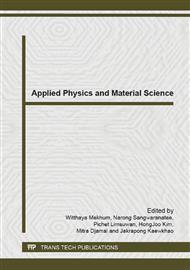p.255
p.259
p.263
p.267
p.271
p.275
p.280
p.285
p.289
Effects of Na2O on Borosilicate Glasses Prepared from Coal Fired Ash
Abstract:
In this work, subbitumious fly ash in Thailand was sintered at different temperatures and analyzed for their compositions and crystal structures. Glasses were prepared from B2O3 mixed with subbitumious fly ash and additive Na2O in various concentrations. The results have shown that SiO2, Al2O3 and Fe2O3 are the major compositions of the fly ash. The crystal structures of fly ash at sintering temperature below to 800 0C are mullite and quartz with the occurrence of hematite phase at 1,000 0C. The density, reflective index and hardness values were found to increase with the increasing of Na2O concentration. The absorption spectra corresponded to the color of the glass (yellow to brown). The higher the Na2O concentration is, the lighter the color of the glasses. The results from this work demonstrated the possibility of glass production from subbitumious fly ash and utilization of industrial waste in Thailand.
Info:
Periodical:
Pages:
271-274
Citation:
Online since:
June 2014
Authors:
Keywords:
Price:
Сopyright:
© 2014 Trans Tech Publications Ltd. All Rights Reserved
Share:
Citation:


